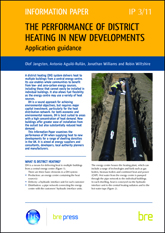
The performance of district heating in new developments: Application guidance Downloadable Version
A district heating (DH) system delivers heat to multiple buildings from an energy centre. It enables whole communities to benefit from low- and zero-carbon energy sources, including those that cannot easily be installed in individual buildings. It also allows fuel flexibility as the energy centre may use a variety of heat sources.
DH is a sound approach for delivering environmental objectives, but requires major capital investment, particularly for the heat distribution network. For both economic and environmental reasons, it is best suited to areas with a high concentration of heat demand. New buildings offer greater ease of installation from the outset but also substantially reduced heat demand.
This Information Paper examines the performance of DH when supplying heat to new developments for a range of dwelling densities in the UK. It is aimed at energy suppliers and consultants, developers, local authority planners and manufacturers.
10 pages.
Contents
What is district heating?
The development of district heating
Policy drivers for district heating in the UK
District heating for new buildings
Heat energy requirements for new dwellings
Dwelling density and heat demand density in district heating areas
Modelling district heating networks for new developments
- Description of the sites modelled
- Heat demand and heat network characterisation
- Calculation of heat distribution losses
Reducing heat distribution losses
- Use of high-performance pipes
- Lowering flow and return heat network temperatures
- Use of smaller-diameter pipes
Conclusions
References
